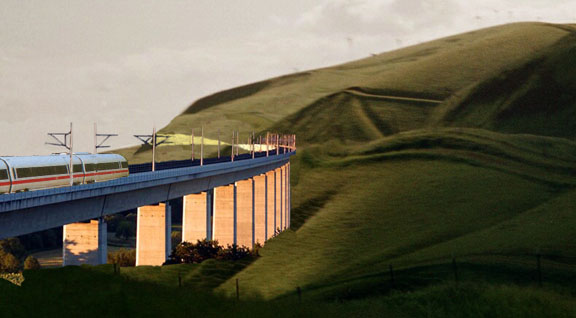

![]()
Why Altamont ? - The EconomicsRidership and service on the statewide HSR network will be determined by demand. The 1999 analysis of the ridership assumed an equal split in the service to all Northern California terminals under any scenario, ignoring actual demand for passengers traveling towards San Francisco/Oakland or San Jose. The level of service was skewed to a single line, because the train schedules ignored true market potential. The Altamont alignment would provide two lines within the inner Bay Area. One would directly serve San Jose and the South Bay, while the second would run up the Peninsula to San Francisco, with the junction in Fremont. The East Bay would be served by direct connections to BART in 1) Amador Valley, 2) Fremont, and 3) downtown San Francisco. In addition, all of the inner East Bay's neighborhoods would be connected to the HSR system via AC Transit's transbay bus system at the Transbay Transit Terminal, the terminal for HSR in San Francisco. Demand estimates indicate there would be a 3-2 split of the trains at Fremont, with greater service up the Peninsula. But this apparent disparity would be neutralized by running regional trains from the South Bay to meet all Peninsula trains and BART trains at the Fremont station. Therefore, in addition to direct statewide HSR service to San Jose, every statewide train would be available to South Bay travelers with a seamless transfer in Fremont. This type of train scheduling is common across Europe. By distributing the demand between the Bay Area terminals, each terminal can avoid artificial congestion. Running all trains through San Jose and up to San Francisco will result in unnecessary congestion or expensive overbuilding at each station. In 1999, construction costs for the Altamont alignment were projected to be $2 billion less than a Pacheco alignment. However, the Pacheco alignment was assumed to generate $56 million more in ticket revenue per year, due to somewhat higher ridership. The analysis by the HSR staff highlighted this gain in annual passenger revenue as a benefit. What was not well portrayed was that this gain in annual revenue does not come close to offsetting the higher construction cost. The additional $2 billion in construction costs would require the payment of approximately $130 million a year over the life of a 30-year bond. This "gain" in ridership is not a true benefit, as it actually costs $74 million annually over the 30-year life of the construction bonds. The 1999 HSR analysis also ignored the potential of commute ridership on the system to Silicon Valley. If just 10% of the San Joaquin County commute market were to be attracted to the system for daily commuting, that would generate 1.3 million annual riders, more than is "lost" in the 1999 analysis. The gain would probably be much higher, given the quality and speed of the service. |
![]()